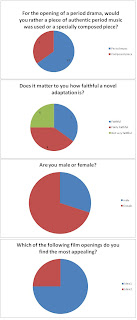For my film opening I have chosen to use only the one location the main character's (a young woman) bedroom. One such location I have chosen is in my house and I have already gained my parents permission to use it. However one of the disadvantages is that there is no wallpaper or decoration suitable for the period. Although a major advantage is that the room is currently empty and unused so I should be able to dress the room more appropriately and should have longer to prepare and a longer window of opportunity for filming than if the room were in use.

For the mise-en-scene I have considered using a newspaper and or calendar to reinforce the date and time period. To represent the main character (a young woman) I have chosen to have a wide range of photographs which the camera will pan across in order to show that the main character likes to keep memento's of her friends and memories etc. On the desk which the main character sits at I plan to various objects typically found on dressing tables such as makeup and accessories such as a hand mirror in order to exemplify that the main character is vain or at least conscious of her appearance as is typical in period dramas. Also on the desk I will now be placing a small card reading "In loving memory" to indicate that the main character has recently lost a close friend or relative (in this case her former lover). 



Finally the last representational objects to symbolise the main character's relationship is a stack of (love) letters and a single photograph of a young man (her deceased lover). I plan to place both objects alone together on top of a table to indicate that the relationship was extremely important to the main character.
For non digetic sound I have been considering using a piece of authentic period music. Although concerns were raised over the issue of Copyrighted material. However now, having looked online at the UK Copyright laws which indicate that all pieces of music produced before 1923 are in the public domain and therefore copyright free At the moment I have found several songs that are both copyright free and representational of the era. Alternatively I could use garageband to create a piece of music myself however after investigating the program I was unable to find or begin to produce anything which I felt was worth using.
I had also originally planned to have just a single piece of music playing non digetically, however I am now considering using some digetic sound possibly in the form of the sounds made by a gramophone before introducing the music to give the appearance that the music is a record being played.



















